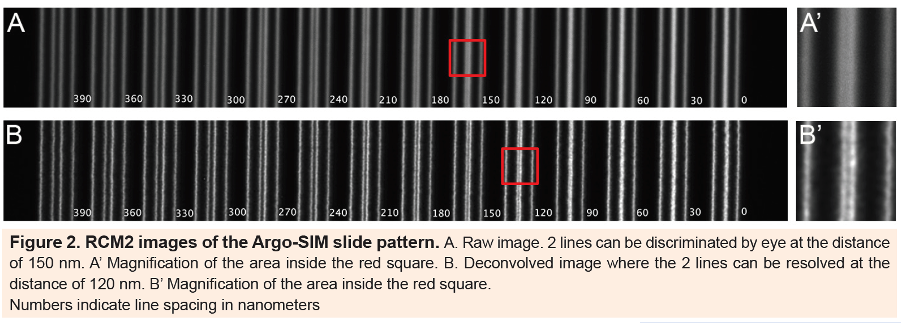How does Confocal NL use Argo-SIM to demonstrate the improved lateral resolution of their Confocal microscope?
ReadThe 2 basics criteria to demonstrate innovative product specifications
Demonstrating performance of new products and technologies can be difficult. The demonstration must fulfill two criteria :
- It must be relevant using the right device to put the increased performance in the spotlight.
- It must be reproducible by others, using standards and protocols that give value to your results.
Here we are presenting the case of Confocal.nl which used an Argo-SIM to demonstrate its lateral resolution enhanced system.

The innovation : Re-Scan Confocal Microscopy
Confocal.nl is a Dutch manufacturer that has developed a technology to improve lateral resolution and increase sensitivity, while maintaining the sectioning capability of a standard confocal microscope. It can upgrade research microscopes. The company was founded in 2016, by Erik Manders and Peter Drent. The 2nd generation of Re-scan Confocal Microscopy (RCM) technology introduced in 2021 is a new super-resolution technique based on standard confocal microscopy extended with an optical unit (re-scanning) that projects the image directly onto a CCD-camera. To demonstrate the resolution of a new system, manufacturers need samples of perfectly known size. Fluorescence polymer beads are usually used. However, Confocal.NL decided to not use beads as they “are sometimes hard to focus on and bleach over time”. In addition, since their size is not infinitely small, they broaden the microscope Point Spread Function (PSF), therefore underestimating the resolution of the optical system. REF
The reference sample : Argo-SIM slide
Rather than beads and PSF, Confocal decided to use an Argolight slide. Some models of Argolight slides contain a fluorescent pattern, dedicated to measurement of resolution. The lines of the patterns are separated by known distances which makes it perfectly fit to measure the ability of systems to distinguish objects. To add value to a measurement, the protocol must be standardized. Argolight provides a free image analysis software Daybook. The method used in Daybook relies on the contrast transfer function, i.e., the measured contrast vs the measured distance between gradually spaced lines. The lateral resolution analysis only provides the minimal resolvable distance between lines close to each other, for a given contrast value, with an associated signal-to-noise ratio (SNR) value in the image.

Measuring Resolution : Results
Confocal.nl imaged the fluorescent pattern of an Argo-SIM slide with their RCM2, using an Olympus IX83 microscope frame with a 100x/1.5 oil objective (UPLAPO100XOHR). In the Argo-SIM, the line pattern consists in pairs of 36 μm-long lines which spacing gradually increases, from 0 to 390 nm, with a step of 30 nm. The pattern was excited with a 405nm laser of an Omicron light hub. The emitted light was detected with a Tucsen FL20-BW camera. In their application note “Lateral resolution of the re-scan confocal microscope 2 measured with the Argolight Argo-SIM slide”, Confocal.nl indicates that:
“The acquisition settings resulted in a pixel size in the specimen plane of 16.5nm/pixel. The z-stepper of the microscope was set to 100nm interval, taking a z-stack of 4 micrometers in total to be able to do proper deconvolution. Subsequently deconvolution was performed by Microvolution with a dedicated RCM point spread function. The figures show the slice of the z-stack with the best focus. Subsequent analysis of the datasets was performed with Daybook 3 software from Argolight, using the Gaussian fit model and a contrast criterion of 7.3% (corresponding to the contrast value equal to the FWHM of the microscope’s PSF in ideal imaging conditions).


“The Argo-SIM slide allowed us to quantitatively and accurately determine the lateral resolution level of the RCM2 without introducing user-bias.” Confocal.nl
Using Argo-SIM slide and its fluorescent patterns, Confocal.nl could accurately confirm that their new system, the RCM2, reaches the specifications previously assigned and achieves super resolution in the images. The results provided by this method are reproducible by other researchers or clients as their protocol is documented and rely on high quality certified standards from Argolight. Argolight is very proud to have been able to provide the tools for Confocal.NL to demonstrate their innovative technology. This article is based on Confocal NL Application note Find out more about the Re-Scan Confocal Microscope 2 Find out more about the Argo-SIM calibration slide
User case: Kyoto University x Argolight – Fluorescent proteins observation
Matsuda Lab, Graduate School of Biostudies/Graduate School of Medicine, Kyoto University Introducing Argolight slides - A New Quality Control...
Quality control of HCS-HTS fluorescence imaging systems
In the landscape of high-content screening (HCS) and high-throughput screening (HTS) fluorescence imaging systems, precision and reliability take...
Precision Partners: Innopsys and Argolight on the InnoQuant Slide Scanners
In the intricate realm of pathology, drug discovery, and advanced research in brain function, cancer, and stem cells, the role of slide scanners has...


